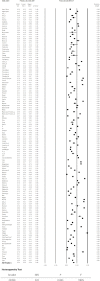Post-traumatic stress in healthcare workers during the COVID-19 pandemic: A systematic review and meta-analysis
- PMID: 36260970
- PMCID: PMC9573911
- DOI: 10.1016/j.psychres.2022.114890
Post-traumatic stress in healthcare workers during the COVID-19 pandemic: A systematic review and meta-analysis
Abstract
The SARS-CoV-2 (COVID-19) pandemic has increased healthcare worker (HCW) susceptibility to mental illness. We conducted a meta-analysis to investigate the prevalence and possible factors associated with post-traumatic stress disorder (PTSD) symptoms among HCW during the COVID-19 pandemic. We searched PubMed, SCOPUS and EMBASE databases up to May 4th, 2022. We performed random effects meta-analysis and moderator analyses for the prevalence of PTSD-relevant symptoms and severe PTSD symptoms. We identified 1276 studies, reviewed 209 full-text articles, and included 119 studies (117,143 participants) with a total of 121 data points in our final analysis. 34 studies (24,541 participants) reported prevalence of severe PTSD symptoms. Approximately 25.2% of participants were physicians, 42.8% nurses, 12.4% allied health professionals, 8.9% auxiliary health professionals, and 10.8% "other". The pooled prevalence of PTSD symptoms among HCWs was 34% (95% CI, 0.30-0.39, I2 >90%), and 14% for severe PTSD (95% CI, 0.11 - 0.17, I2 >90%). The introduction of COVID vaccines was associated with a sharp decline in the prevalence of PTSD, and new virus variants were associated with small increases in PTSD rates. It is important that policies work towards allocating adequate resources towards protecting the well-being of healthcare workers to minimize adverse consequences of PTSD.
Keywords: COVID-19; Healthcare workers; Mental health; Pandemic; Post-stress distress; SARS-CoV-2.
Copyright © 2022 Elsevier B.V. All rights reserved.
Conflict of interest statement
Declaration of Competing Interest The authors declare no competing interests.
Figures






References
-
- Alah M.A., Ali K., Abdeen S., Al-Jayyousi G., Kasem H., Poolakundan F., Al-Mahbshii S., Bougmiza I. The psychological impact of COVID-19 on health care workers working in a unique environment under the umbrella of Qatar Red Crescent Society. Heliyon. 2021 doi: 10.1016/j.heliyon.2021.e07236. - DOI - PMC - PubMed
Publication types
MeSH terms
LinkOut - more resources
Full Text Sources
Medical
Miscellaneous

